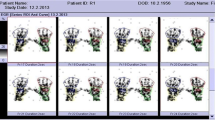Abstract
No large prospective study is available on use of a radionuclide method to assess frostbite and its response to conservative treatment. Recently, a large retrospective study using two-phase bone scintigraphy suggested that non-uptake (or low uptake) in frostbite lesions in the blood pool or bone phase had a strong correlation with the subsequent need for amputation. In the present study, we performed early blood pool scintigraphy with technetium-99m pertechnetate in 20 patients (10–180 days after frostbite injury; 71 clinical lesions) referred for a topical treatment protocol for mild to moderately severe frostbite, and in 22 asymptomatic controls. The aims of the study were to define the "normal" microcirculation of the hands and feet, to characterise the appearances of frostbite lesions on scintigraphy and correlate these with the clinical presentation, and to evaluate the usefulness of scintigraphy for assessing the treatment response. Six patients were "fresh", 12 had been undergoing conservative treatment (topical homeopathic) for several weeks and two had permanent fibrotic hand phalanges. Nine patients on treatment underwent serial scintigraphy a total of 22 times. Eleven patients were imaged only once, including the two with permanent fixed defects. Three distinct physiological microcirculation patterns were evident in control hands or feet: right- or left-handedness (seven subjects), subclinical inflammatory foci correlating with callosity or pressure points (36 lesions) and distinctly increased pooling of radiotracer at the thenar or hypothenar region (eight subjects). In frostbite patients, 128 lesions (48 inflammatory, 80 ischaemic) were seen on the scan. This number included all 71 lesions identified clinically, the rest being subclinical. Subclinical frostbite lesion as an entity has not been described previously. Microvasculature of normal muscle groups (in the hands, elbow or feet) was shown on scintigraphy to improve after topical treatment. The treatment resulted in improved or normalised perfusion scan in 25 of 45 ischaemic segments with matching clinical improvement, and reduction or normalisation of uptake in inflammatory lesions (n=30). The data confirm the vasodilator and anti-inflammatory action of the topical preparation, and the sensitivity of the radionuclide method in monitoring treatment response. In contrast to the previous findings that non-uptake on a scan performed 2 or more weeks after exposure correlates with the need for amputation, none of the 80 ischaemic lesions in our series required amputation while 60% showed improvement or normalisation in microvascular blood flow even though they were 10–180 days old. Our findings suggest that moderate to severe frostbite lesion can be classified as having infarcted, ischaemic or hibernating (viable) tissue, similar to the classification employed when using myocardial scintigraphy. Absence of uptake even after the initial 10 days does not necessarily indicate infarction and the need for amputation as many such lesions retain potential for vasodilation and recovery.
Similar content being viewed by others
Author information
Authors and Affiliations
Additional information
Received 13 June and in revised form 3 September 2001
Electronic Publication
Rights and permissions
About this article
Cite this article
Bhatnagar, A., Sarker, B., Sawroop, K. et al. Diagnosis, characterisation and evaluation of treatment response of frostbite using pertechnetate scintigraphy: a prospective study. Eur J Nucl Med 29, 170–175 (2002). https://doi.org/10.1007/s00259-001-0658-4
Published:
Issue Date:
DOI: https://doi.org/10.1007/s00259-001-0658-4




